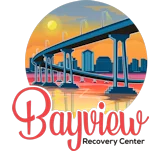Bipolar and Addiction Treatment in California
Bipolar disorder, also called manic-depressive illness, is a brain disorder. If you or someone you care about is struggling to medicate themself to ease their symptoms, there’s a very real possibility that you also have a substance use disorder (SUD, addiction).
Left untreated, each condition worsens the other, so they must be treated simultaneously. You can find a dual diagnosis treatment program at Bayview Recovery Center in San Diego, California.
What is Bipolar Disorder?
- Energy
- Mood
- Activity levels
- Concentration
- The ability to perform day-to-day tasks
Bipolar disorder encompasses three primary diagnoses: bipolar I, bipolar II, and cyclothymic disorder. This condition often has a familial tendency, with 80 to 90 percent of those affected by bipolar disorder having a family member who also suffers from bipolar disorder or depression. There are several types of bipolar disorder. Each has distinct characteristics:
Extreme mood swings characterize this type of bipolar disorder. This includes at least one manic episode that lasts for a week or longer, or requires hospitalization. The individual may or may not have experienced a major depressive episode, but they are common. Bipolar I can also involve mixed episodes, where symptoms of both depression and mania occur at the same time.
Bipolar II features periods of elevated mood, more energy, and activity levels that are less severe than the full-blown manic episodes in bipolar I. The severe periods of depression are comparable to major depressive disorder.
Cyclothymia is a chronic mood disorder characterized by many periods of depressive symptoms and many periods of hypomanic symptoms that last for at least two years. The symptoms are less severe than those in full-manic or major depressive episodes.
This is bipolar I or II with rapid cycling. This means there have been four or more depressive, manic, hypomanic, or mixed episodes within a year. There may be stable weeks between episodes, or episodes that last months, weeks, or days.
This type is when a person experiences depression and mania or hypomania simultaneously or very quickly after each other. It’s sometimes called mixed bipolar state or mixed affective bipolar.
The seasons or time of year regularly affect mood episodes.
The symptoms don’t quite fit into the diagnosis of the other types of bipolar disorder. However, this doesn’t mean that the symptoms are any easier or that treatment and support aren’t needed.
Signs and Symptoms of Bipolar Disorder
Bipolar disorder is defined by severe mood fluctuations, alternating between episodes of mania (or hypomania) and depression. Manic phases may include feelings of euphoria, heightened energy, and rapid thoughts, whereas depressive phases can manifest as deep sadness, low energy, and a disinterest in activities. These symptoms can greatly interfere with daily functioning and interpersonal relationships.
Manic/Hypomanic Symptoms
During a hypomanic or manic episode, an individual may experience these symptoms:
- Increased activity, energy, and restlessness
- Impulsivity and reckless behavior: Participating in hazardous activities such as excessive spending, reckless driving, or unsafe sexual practices.
- Grandiosity: Possessing an exaggerated sense of self-importance or believing in one’s ability to achieve extraordinary feats.
- Irritability: Being easily annoyed, agitated, or prone to anger.
- Exaggerated feeling of well-being and extreme happiness
- Reduced need for sleep
- Abnormal talkativeness
- Racing thoughts and speech
- Easily distracted
- Poor decision-making, such as risky sexual behavior, reckless spending, or unsound investments
Depressive Symptoms
In a depressive episode, a person might experience:
- Feelings of hopelessness or worthlessness
- Lack of interest or pleasure in most activities
- Notable weight loss or gain; increased or decreased appetite
- Hypersomnia (sleeping too much) or insomnia
- Fatigue and loss of energy
- Diminished ability to think or concentrate
- Thoughts of suicide or death
Causes of Bipolar Disorder
The exact cause is not understood, but it is believed to be caused by a combination of factors, such as:
- Genetics–bipolar disorder frequently runs in families. Implying a genetic predisposition
- Brain structure and function–variations in the function and structure of certain areas of the brain may play a part.
- Neurotransmitters (brain chemicals)–imbalances in neurotransmitters, such as serotonin, dopamine, and norepinephrine, are believed to contribute to mood swings.
- Environmental factors–trauma, stress, or significant life changes can produce episodes in susceptible people.
Prevalence of Co-Occurring Disorders
Co-occurring disorders can include any combination of two or more SUDs and mental disorders identified in the DSM-5, a reference book on mental health and brain-related disorders. According to SAMHSA’s 2022 National Survey on Drug Use and Health, about 21.5 million adults in the United States have a co-occurring disorder.
In addition, about 37% of people with alcohol use disorder (AUD) also have a serious mental health condition. This number rises to 53% for people with substance use disorders. Furthermore, individuals with mental health conditions are at a higher risk of developing SUDs and vice versa. The most common mental disorders include:
- Anxiety and mood disorders
- Schizophrenia
- Bipolar disorder
- Major depressive disorder
- Conduct disorders
- PTSD
- ADHD
Individuals being treated for mental disorders often abuse these substances:
- Alcohol
- Opioids
- Stimulants
- Marijuana
- Hallucinogens
- Prescription drugs
Bipolar Disorder and Substance Abuse
Substance abuse and bipolar disorder frequently co-occur. This creates complex challenges for healthcare professionals and the individual themself.
The Relationship Between Bipolar Disorder and Addiction
People with bipolar disorder are much more likely to develop a substance use disorder than the population in general. This can be connected to several factors:
- Self-medication: Some people with bipolar disorder may use substances to cope with the intense mood swings, depression, or mania related to the condition. Sedatives or alcohol may be used to calm manic episodes, and stimulants might be used to relieve depressive symptoms.
- Neurobiological factors: There may be shared neurobiological and genetic susceptibilities that predispose people to both SUDs and bipolar disorder.
- Impulsivity: During hypomanic and manic episodes, people with bipolar disorder may show increased impulsivity and risk-taking behaviors. This can lead to substance experimentation and abuse.
- Environmental and social factors: Trauma, stress, and social isolation contribute to both conditions and their co-occurrence.
Dual Diagnosis Treatment
Co-occurring mental health disorders are treated with a combined approach that treats both the mental health condition and the SUD simultaneously. This method is crucial and recognizes that the two conditions often act on each other. Treatment usually consists of a combination of therapy, medication, and support services.
Diagnosing Bipolar Disorder and Substance Abuse
Bipolar disorder and SUD are diagnosed by healthcare professionals using a combination of clinical interviews, symptom assessment, and occasionally, psychological testing. Due to overlapping symptoms, diagnosing bipolar disorder when there is SUD present can be complicated, but it’s essential for treatment.
Bipolar Disorder and Substance Abuse Treatment
Effective treatment for bipolar disorder and SUD involves an integrated and comprehensive approach, treating both conditions simultaneously.
- Medication management: Mood stabilizers, antidepressants, and antipsychotics are often prescribed to manage bipolar symptoms. It’s crucial to watch for drug interactions with substances and compliance with the medication plan.
- Psychotherapy:Cognitive-behavioral therapy (CBT) helps people recognize and change their problematic thought patterns and the behaviors that arise as they’re related to both bipolar and substance use. Dialectical behavior therapy (DBT) focuses on distress tolerance, emotional regulation, mindfulness, and interpersonal skills, which are beneficial in addressing both conditions. Family Therapy can help family members who wish to participate understand and be better able to support the person’s recovery, while they learn to take care of themselves. Participating in support groups like Alcoholics Anonymous (AA) or Narcotics Anonymous (NA) provides peer support and a structured recovery plan. Group therapy sessions also provide peer support, accountability, and insights from other group members in a structured setting led by a therapist or therapists. Educating people and their families about SUD and bipolar disorder is necessary for understanding the conditions and effectively managing them. Forging strategies, such as a relapse prevention plan to help identify triggers and cope with cravings, is critical for long-term recovery.
Unique challenges present when treating co-occurring disorders. From the beginning, there is difficulty in making an accurate diagnosis because the substance use may mask symptoms and issues with medication compliance. Individuals may also face the double stigma of both addiction and mental illness. This plays into the lack of motivation for treatment, especially during mood episodes or periods of intense cravings. Lack of motivation makes consistency in medication and therapy challenging. And finally, finding comprehensive treatment programs that specialize in co-occurring disorders can be difficult.
Receive Dual Diagnosis Treatment at Bayview Recovery Center
Bipolar disorder and substance abuse are serious conditions that require a specialized, comprehensive treatment program. By addressing both conditions at once, you can achieve stability, improve your well-being, and lead a fulfilling life. If you or someone you care about is struggling with this dual diagnosis, getting professional help is the first step to recovery for both conditions.
Bayview Recovery Center in San Diego, CA, can offer you just such a program. Our experienced medical and mental health professionals will help you stay motivated and on track for recovery. We have three outpatient programs, an aftercare program, and a sober living environment to help you with a smoother transition to sober independence and assistance with training and job placement.
Don’t give up on yourself or your loved one. Bayview will prepare you and the whole family for the challenge ahead. And if your loved one balks at the idea of rehab, we will help you stage an intervention. This is the time. Contact us today.

Alyssa is a licensed Clinical Social Worker and received her Master’s degree from San Diego State University. She has experience working with individuals in recovery of all ages for over eight years. Alyssa has also worked with at-risk homeless foster youth transitioning into independent living along with the families in the neonatal intensive care unit at UCSD.
